When my furgon minibus first spat me out at Gjirokaster’s bus station, my first thought was “wait, is this it?”.
Surrounded by modern flats and shops along a wide boulevard, I briefly wondered if I had gotten on the wrong bus. However, soon it became clear that Gjirokaster has two parts that feel mostly separated from each other.
At ground level there is a modern area, while the UNESCO-listed old town is in the upper areas dramatically built on the slopes of the Gjere mountains — and it’s here you’ll find the narrow tangled streets and many historic 17th century Ottoman-era houses.
What Albanian cities like Tirana or Vlora may lack in historical charm, Gjirokaster has in spades. This Gjirokaster travel guide covers everything you need to know to get the most out of your visit.

Is Gjirokaster worth visiting?
Contrary to what you might read online, I personally found Gjirokaster genuinely remarkable and actually worth adding to your Albania itinerary.
It was actually one of my favorite places in Albania and I would rate it as the most interesting historical city (well ahead of Berat). But as always, expectations are everything, so let me try to paint a picture for you.
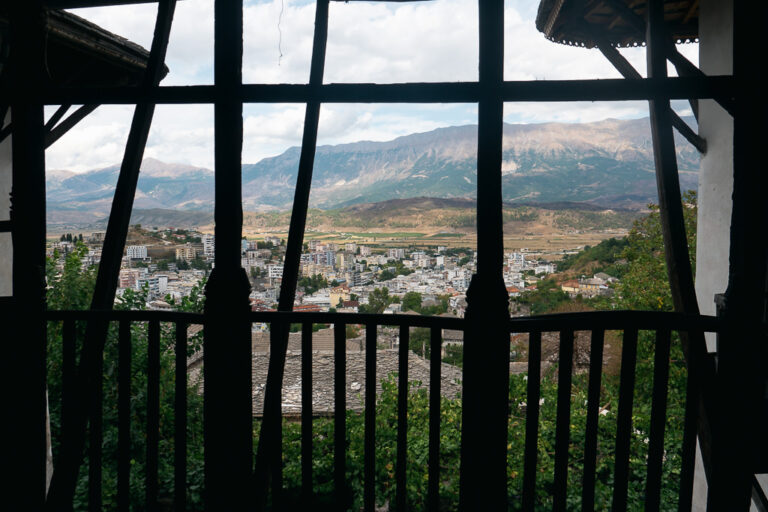
I should say that Gjirokaster is not a particularly big place. Activity in the old town centers mostly on a five-way junction of cobbled streets — it’s here that most taverns, souvenir shops and guesthouses are clustered. The tourist center radiates out at most maybe 500 meters in each direction from this central point.
While quite small, I found Gjirokaster highly charming. I loved the low-traffic and walkable old town with its many 17th-century two-story stone houses — and with street views often featuring backdrops of green hills or Gjirokaster Castle’s outer walls.
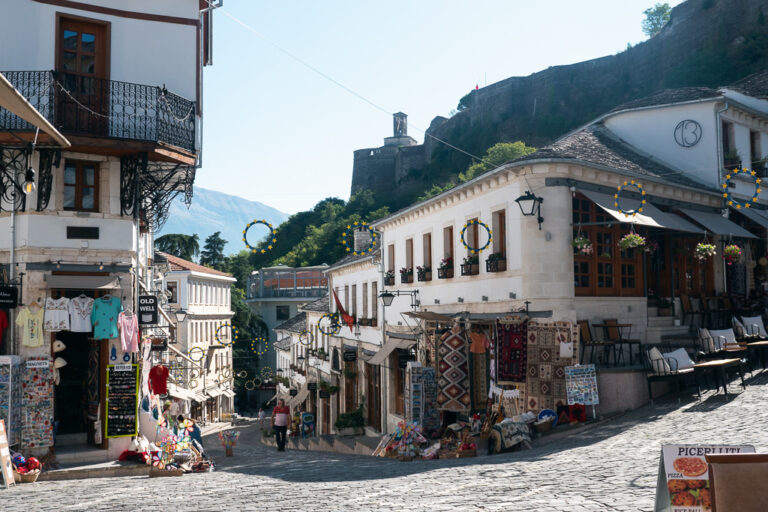
This castle is really the one big attraction in Gjirokaster. Beyond this, expect mostly a few smaller sights and museums. If you’d enjoy visiting an old merchant house or maybe lingering in a tavern for a traditional Albanian meal, then you’ll have plenty of stuff to do in Gjirokaster.
In short, yes, I think Gjirokaster is highly worth visiting. It’s a quaint historical place with a collection of small sights and many cute restaurants/cafes that make it a great place to spend some time.

Day trip vs. staying in Gjirokaster
Staying in town overnight lets you capture the vibe a lot more, which I seriously recommend. You’ll also be there in the evening, when the cosy street lights and restaurants with outdoor seating make it a particularly lovely place to be.
I even include Gjirokaster as a 3-day essential stop in my 2 Albania itineraries, but for a slow-paced exploration of the city itself, 1 or 2 full days is ideal.
If you’re adding a trip into the surrounding region or a day trip to Permet for some river rafting or hiking, then that could easily justify a longer stay. (Personally, I stayed 4 nights, but just so I could get the complete picture for this guide. The average visitor would probably consider that too long.)
If you’re looking for bigger attractions, then maybe Gjirokaster is more of a day trip place for you just to get the highlights. Overall, I think it’s worth paying even a quick visit. Here are some options for organized day trips:
- Tour leaving daily from Sarande — visit Gjirokaster as well as the Blue Eye watering hole and the Mesopotam Monastery. It’s about an hour’s drive point to point from Saranda, making this a perfect day trip option.
- From Durres or Tirana — a full day trip to Gjirokaster. Note it’s 3+ hours driving one way, so you will need to be committed to this idea. I would personally consider doing this tour but staying in Gjirokaster for a night before continuing the trip.
Besides a day trip, you can also use Gjirokaster to break up a journey between, say, the capital Tirana and the Albanian Riviera along the coast. Just take a bus or furgon from the capital, check into a hotel in Gjirokaster for a night, then grab your next transportation to, say, Sarande or Vlora.If you need some ideas for how to fit Gjirokaster into your route, I have some detailed itineraries for Albania.
Where to stay in Gjirokaster
Gjirokaster has a wide range of accommodations — mostly smaller-scale guesthouses and some boutique hotels housed in some of the historical buildings.
If you’re backpacking then be sure to stay in the phenomenal Stone City Hostel, which currently sports a 9.9 (!) rating on Hostelworld and justifiably so. Its owners created one of the most homely hostels I’ve ever stayed, where travellers chat with each other at one large table every morning over breakfast. It’s a calm but social hostel where you will instantly feel at home.
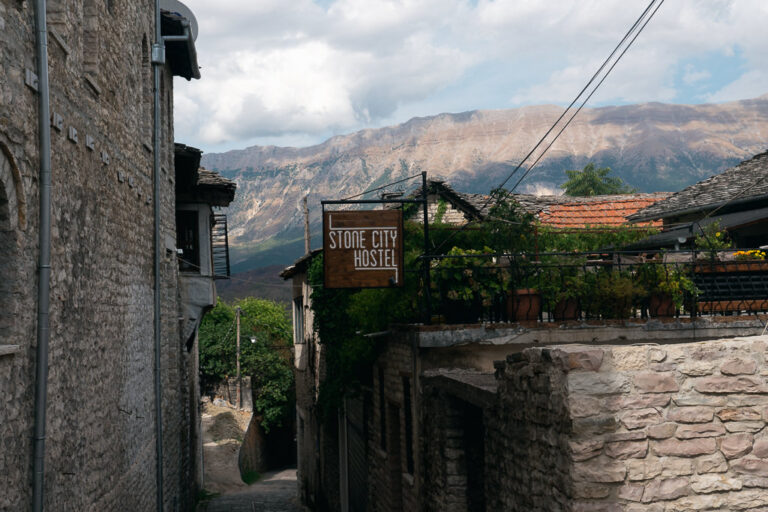
I split my time between this hostel and Vrenjo Guesthouse just down the street. This local apartment offers good value and a cosy vines-clad courtyard where you can have your breakfast. I would suggest it specifically for budget travellers looking for a basic and centrally located place.
For something a bit more stylish or romantic, I suggest Guri Guesthouse, which has traditional stone quarters and a spectacular terrace overlooking the town and the castle.
If you’re more into the idea of a hotel, look no further than the somewhat plainly named (but lovely) Hotel Gjirokaster. It’s in a perfect location close to the Bazaar, has large balconies overlooking the town, and has a swimming pool too.
13 Best things to do in Gjirokaster
Gjirokaster may not have an infinite list of things to do, but I was personally more inspired by the variety of small activities than the rather sparse selection in Barat (another ancient city with which it shares its UNESCO World Heritage listing).
Besides the city itself, I highly recommend exploring the surrounding region which features wild rivers, impressive mountain peaks, and forgotten roads to small villages.
1. Explore Gjirokaster Castle
- Opening hours: Every day, 9:00 AM – 7:00 PM
- Admission fee: 400 Lekë
- Check map location
The focal point of this enchanting city is the Gjirokaster Castle, a towering fortress that dates back to the 14th century. This is one site you absolutely cannot miss during your stay.
What we see today dates back to the early 19th century and stretches across the 1,100-foot-high hillside like a giant ship made of stone. Not only will you be able to travel back in time as you wander the grounds, spotting the clock tower, the church, and the arched walkways, but you’ll also find the most rewarding views of Gjirokaster from here.
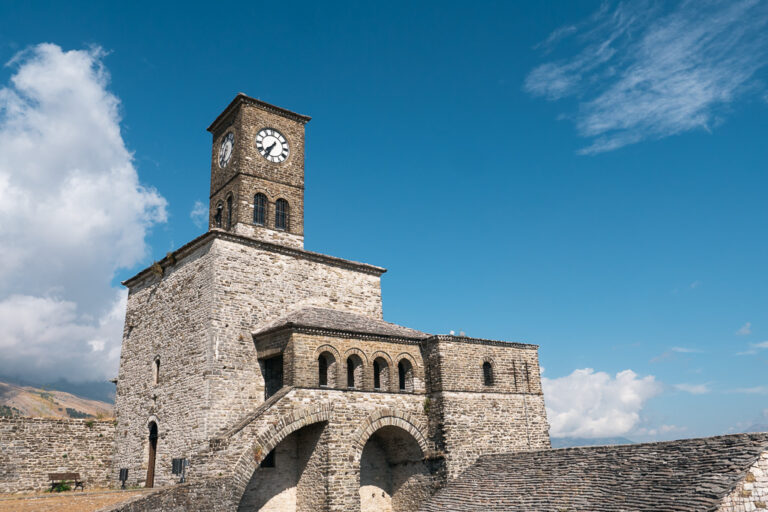
Another cool way to look at it is as a vantage point. From up there, the city spreads out below with its old stone houses, slate roofs, and those winding cobbled streets. You can see the green valley stretching out to the Drino River.
To see it all, you’ll have to tackle a steep walk from the town then wander the ramparts and climb the towers, so a reasonable level of fitness is necessary. On a clear day, the view makes the climb feel way less like a workout and more like something you actually want to hang out and stare at.
If you’re visiting in summer, I’d recommend exploring it early in the day, to avoid working up a serious sweat under the Albanian sunshine.

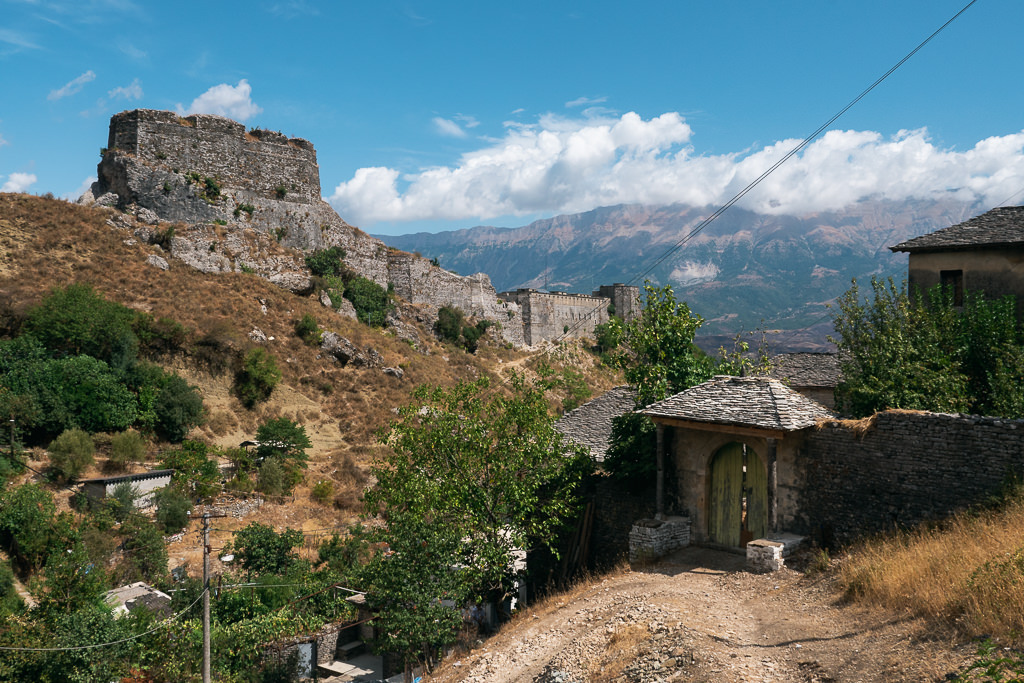
2. Learn the history at Castle’s Museums
Gjirokaster Museum
- Opening hours: Every day, 9:00 AM – 7:00 PM
- Admission fee: 200 Lekë
- Check map location
Arms Museum
- Opening hours: Every day, 9:00 AM – 7:00 PM
- Admission fee: 200 Lekë
- Check map location
Gjirokaster Castle is also home to some museums, each of which you can enter for a small additional fee, including the Gjirokaster Museum and the Arms Museum.
The Gjirokaster Museum is the best place to learn about the history of this long-standing castle and the city itself. Having been conquered multiple times, this museum brings Gjirokaster’s turbulent past to life, from photos depicting life during Communist times to artifacts from the Ottoman Empire.
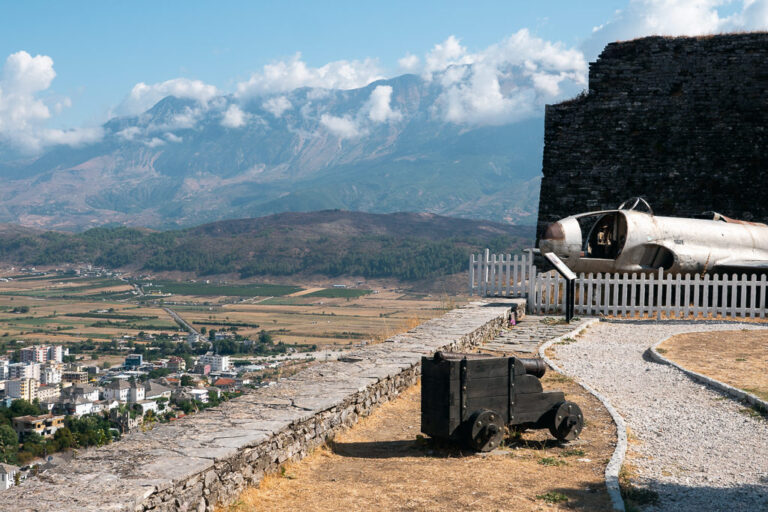
Anyone interested in weaponry should stop by the Arms Museum. It’s not as informative as the Gjirokaster Museum, but you’ll find the likes of World War II machinery and centuries-old guns inside.
Perhaps the coolest addition to the Arms Museum is an old plane belonging to the U.S. Air Force, which some believe was taken down during the Cold War.
3. Explore the Old Town
I know, this suggestion doesn’t sound particularly original. But it’s a fact that one of the best things to do in Gjirokaster is to simply stroll around the Old Town, which has been wonderfully well-preserved.
Everywhere you look, you’ll be greeted by fine examples of white Ottoman architecture, cosy cobblestone streets, and hilly walkways.


You’ll have your pick of cute cafes, and restaurants dotted along the streets, which are the perfect places to grab a bite to eat and watch the world go by. This part of town is even prettier when the sun starts to go down, as fairy lights make each street even more magical.

For a chance to see everything forfree,this 2-hour walking tour leads you through Gjirokaster’s bustling Cerciz Topulli Square and the Old Bazaar, before climbing up to the hilltop majesty of Gjirokaster Castle — with plenty of fascinating stories and hidden gems along the way.
I use the site Guruwalk to find free walking tours. These tours are not entirely ‘free’ but tips-based. Just remember that for most guides, this is their full-time job and therefore only source of income. So pay fairly!
book for free on guruwalk4. Visit the Skenduli House
- Opening hours: Every day, 9:00 AM – 7:00 PM
- Admission fee: 300 Lekë
- Check map location
The best place to see the Ottoman architecture up-close is the Skenduli House, an authentic Gjirokaster home that had been in the same family for generations — and now turned into a small museum.
Built in the 1700s by a wealthy Ottoman administrator, the house reflects the family’s status with its 9 fireplaces, 6 bathrooms, 12 rooms, 44 doors, 64 windows, and 4 Turkish baths—the more fireplaces, the greater the wealth.

The family was forced out when the Communists seized the house in 1981, turning it into the Ethnographic Museum. It was returned in 1993 and has remained open to visitors ever since.
Skenduli House is today still operated by a descendant of its original owners, who you’ll more than likely be guided by when you visit.
During the free walking tour, you’ll be given an insight into life in Gjirokaster during the 1700s as you explore bedrooms, living spaces, and a bunker, but the premier room, complete with a fireplace and frescoes.
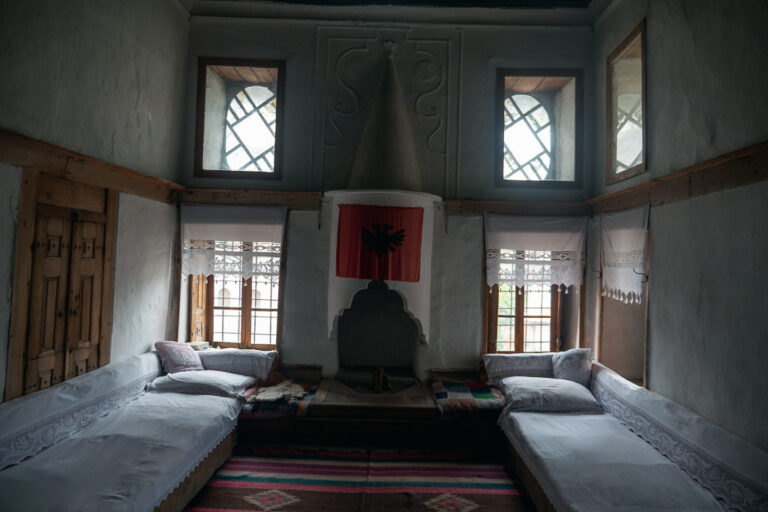
5. Ismail Kadare’s house
Beyond the architectural beauty of centuries-old mansions, the Ismail Kadare House holds deep cultural heritage as the home where one of Albania’s greatest literary minds, Ismail Kadare, lived and wrote.
In 2019 his house in Tirana, where wrote most of the books, was transformed into a museum and opened to the public.
The house itself is described in detail in his book Chronicle in Stone, where the little Kadare standing by the window viewing his grandparents, townspeople, and many scenes from World War II.
Architecturally, it reflects the features of a 19th-century Gjirokastra house, with a stone roof, arched corridors, and wooden details. Inside, it gets even more interesting with many original objects belonging to the family as well as Kadare’s original study, personal library, and manuscripts.
A visit here offers a rare opportunity to explore the cradle of this brilliant historical figure— and to appreciate this small mountain city which inspired such influential minds.
6. Experience the eerie Cold War Tunnel
- Opening hours: Every day, 9:00 AM – 6:00 PM
- Admission fee: 200 Lekë
- Check map location
When Gjirokaster native Enver Hoxha became increasingly paranoid about foreign invasion during the 1970s, he began building countless bunkers throughout Albania, including the Cold War Tunnel.
This 59-room pit was built to shelter the likes of government officials and elite members of society from potential nuclear attacks. It remains very much in its original state today, minus some stolen furniture.
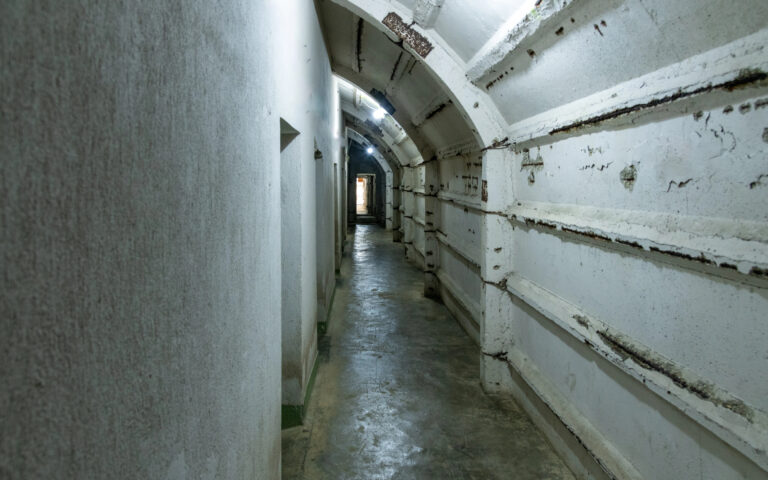
Tours run every hour and last for around 30 minutes, during which your guide will give you some background information and an explanation of various rooms in the bunker.
If I can give you one piece of advice, it’s to bring a jacket or cover-up of some sort, as it’s pretty chilly in here even when it’s a blistering 95°F outside.
7. Take a 4WD jeep tour into the valleys
This was actually my favorite activity during my stay here, though I should say it was a custom tour that’s run by the owner of Stone City Hostel, so it’s probably only available if you stay in this hostel. (If you’re not, perhaps you can find a similar tour offered locally.)
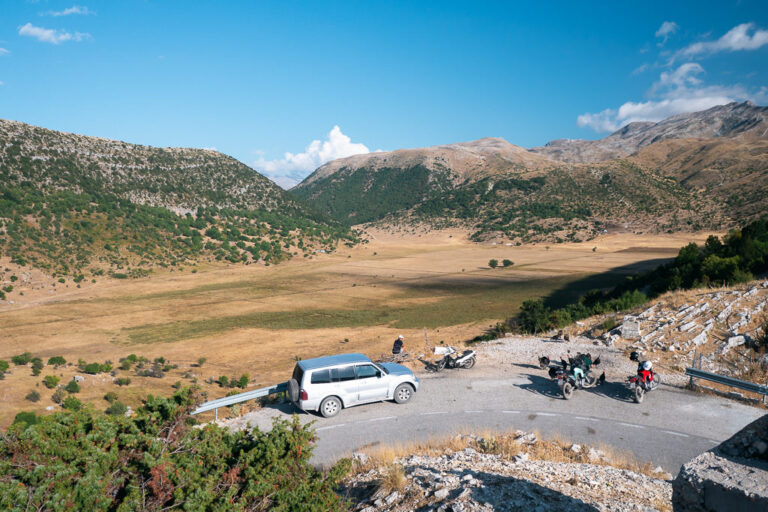
The hostel owner took a few of us into the nearby countryside in his 4×4 vehicle. It was literally an off-the-beaten-track experience, since some of the roads to the villages were unpaved and we were very far from anything remotely ‘touristy’.
The trip lasted the whole day, taking us to a hidden waterfall, a small Byzantine church with gorgeous frescoes, and a still mostly unexcavated Roman city, among many other small sights.
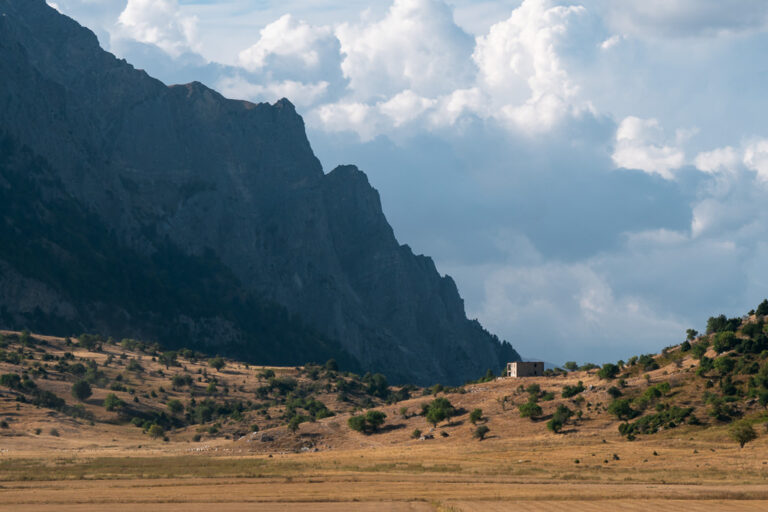
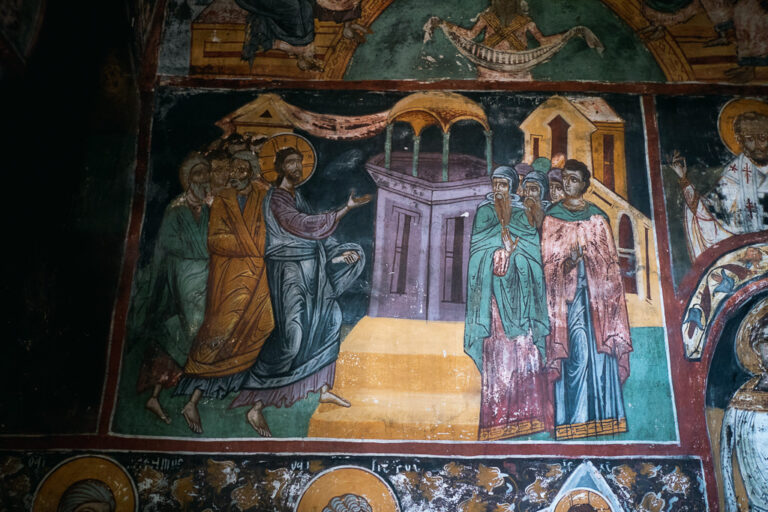
Heading deeper into the Albanian countryside and getting a snapshot of rural life was fantastic. The tour was mostly about small sights, but if you would enjoy going to some remote place to see a forgotten, crumbling Ottoman stone bridge, or an abandoned communist monument, then this one’s for you.
8. Browse the shops at Gjirokaster Bazaar
Within the Old Town lies the Gjirokaster Bazaar. Now, just to set expectations, this is not some large roofed shopping space as you might imagine from bazaars in Turkey or Morocco. This is really just two streets lined with small shops, though they are in the exact historic location where merchants gathered since ancient times.
Having once stood as a traditional marketplace for locals for hundreds of years, today, the winding streets of the bazaar mostly cater to tourists.

This is where you’ll want to stock up on souvenirs, as there are heaps of stores selling unique trinkets and colorful keepsakes, from patterned carpets and handmade jewelry to ceramics and artworks.
When you’ve had enough retail therapy, head to one of the ice cream parlors or bakeries and pick up a sweet or savory treat.
9. Step Inside the Bazaar Mosque
- Opening hours: Weekdays, 9:00 AM – 4:30 PM
- Admission fee: Free
- Check map location
When Gjirokaster was under Ottoman rule, the city boasted fifteen mosques, most of which existed up until Albania became a communist state. All these places of worship were destroyed during this time, aside from the Bazaar Mosque.

Unless you practice Islam, you can’t enter during prayer times, but you’ll often find people worshipping at any time of the day, and you might even encounter the imam during your visit.
At present, the mosque is free for all to enter, though it’s important to remember to dress conservatively and ensure your shoulders and knees are covered when you arrive.
10. Take a day trip to Permet
Only an hour from Gjirokaster, the still little-known city of Permet is the perfect base for nature experiences. While you could stay there overnight (and I have a whole travel guide dedicated to Permet), it is also well within day trip range of Gjirokaster if you don’t want to change accommodation too often.
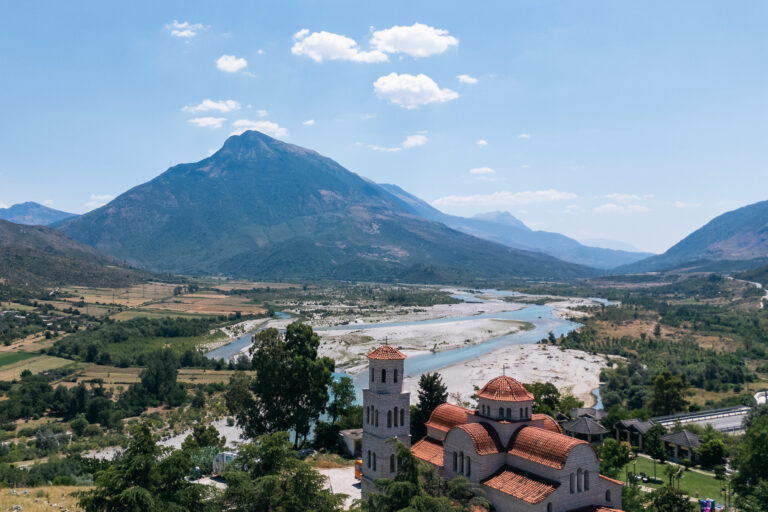
Permet is in the middle of the new Vjosa Wild River National Park, which protects one of Europe’s last remaining truly wild rivers. The best thing to do in Permet is to go down the Vjosa on a rafting trip.
If you’ve never rafted before, don’t worry — this activity is very accessible as the river is fairly calm during the spring/summer tourist season. Think of it as kayaking or river tubing through beautiful scenery, with an occasional rapid thrown in.

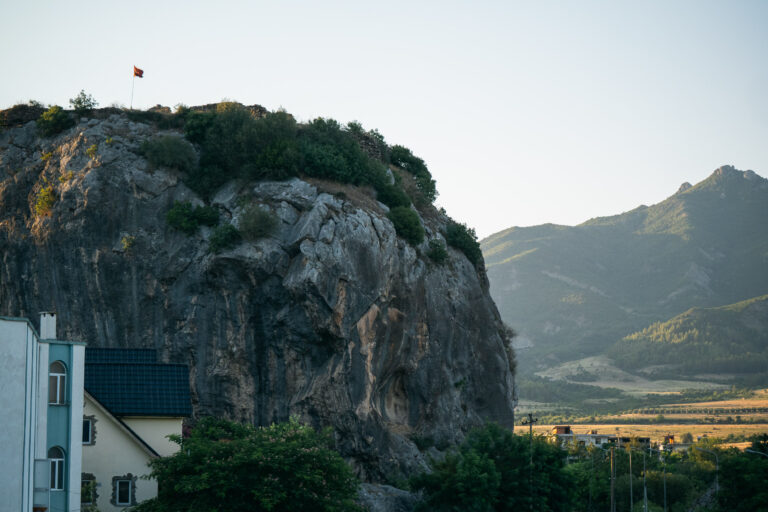
Besides rafting, the other spectacular activity in Permet is to hike up the Langarica Canyon, through which runs one of the Vjosa’s tributaries. This hike among the steep rocky walls is easily one of my favorite in Albania.
There’s also this guided tour that mixes the canyon trek with a soak in Permet’s thermal baths, so you get both adventure and chill time. It’s a great way to see the raw landscapes up close and then relax in the warm, mineral-rich waters. You can even get picked up from Gjirokastër or Sarandë if you’re not staying in town.
11. Appreciate Albanian cuisine with a culinary class
If you fancy trying something a little different, throw your apron on and learn some recipes that you can show off to your loved ones back home on your return!
Albania has some seriously tasty food, but Gjirokaster also has some of its own specialties, such as qifqi, shapkat, and japrak. Cooking classes are always so much fun, even if you’re a complete novice and don’t rate your culinary skills very highly.
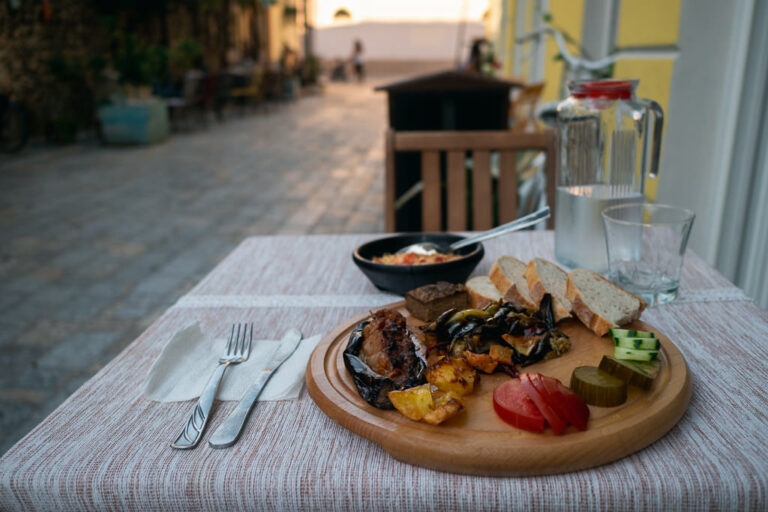
To whip up some Albanian favorites, check out this local-focused class. However, this vegetarian class is an excellent alternative if you prefer to go meat-free, and it even includes some complimentary raki. For those of you who have yet to try raki, this is Albania’s homemade, typically very strong, spirit of choice.
12. Hike to the Ali Pasha Bridge
Despite being a less visited spot than some of the other places on this list, trekking up to the Ali Pasha Bridge is among the top things I’ve done in Gjirokaster.
This stone bridge is the only remnant of the 19th-century aqueduct that brought fresh water into the city and is one of the most remarkable sites outside of the Old Town.
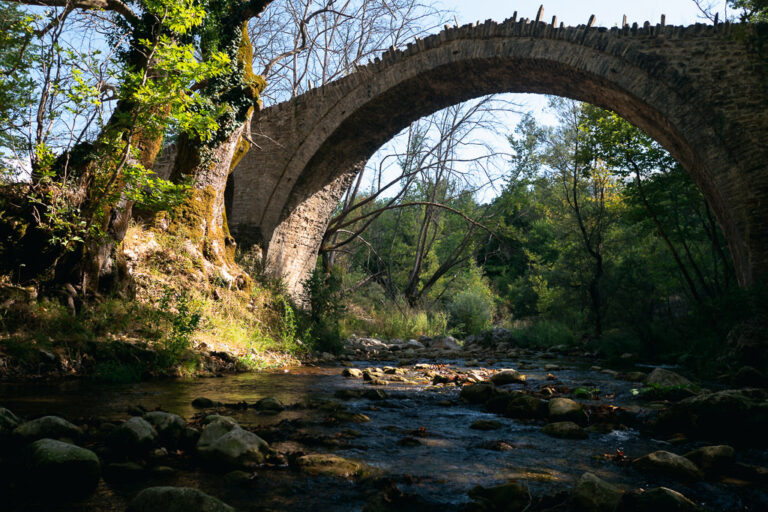
You’ll have to tackle a short but arduous hike to reach the bridge, with some rocky and steep patches along the way, though it should only take you around 30-40 minutes to complete.
Head off early in the day if you’re making the trek during the summer, as there’s very little shade for most of the trail.
P.S. Anyone with a fear of heights should be warned that the path across the bridge is free of fencing, which can be pretty unnerving.
13. Admire the vivid Blue Eye
Located around an hour’s drive from Gjiokaster is this natural spring with crystal clear blue waters that need to be seen to be believed!
Aptly called the Blue Eye, this natural phenomenon is quite magical and due to its visual appeal predictably features quite often on social media. Just know that it has become one of Albania’s most beloved attractions, so it can get a little crowded at times.
Though several Albanian legends tell the story of how this site came to be, the water comes from an underwater cave, which forms the pupil of the ‘eye.’ Divers have made it to 50 meters below the surface of the spring, but it remains unknown just how deep the water goes.

To protect the clarity of the water, swimming is not allowed here. Unfortunately, many people continue to disregard the rules, and it’s not uncommon to see people bathing or jumping in.
The Blue Eye is located roughly halfway between Gjirokaster and Sarande, so if you’re heading to the coast it’s an easy place to check out on the way. I should mention that there are two places called the Blue Eye in Albania — the other is almost 300km further north in the Albanian Alps, so if you’re checking the pictures first, make sure which one you’re looking at.


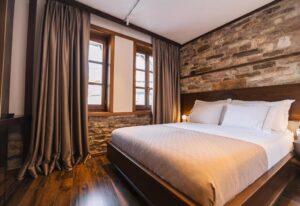
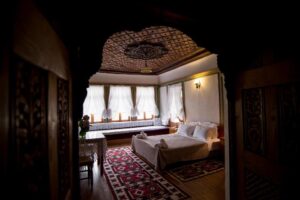
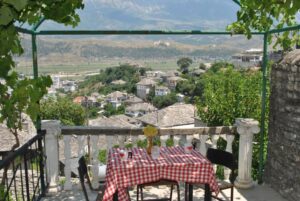
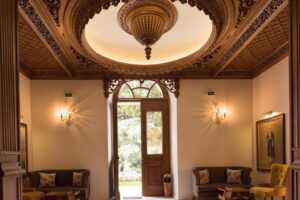
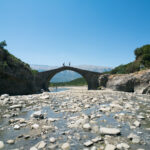
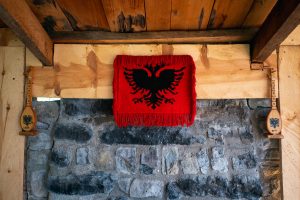
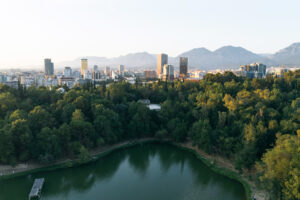

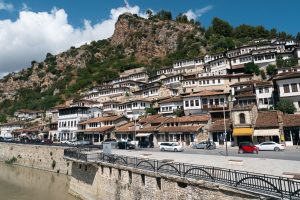

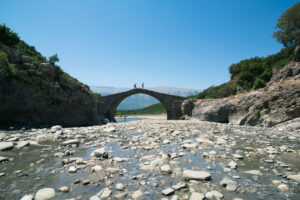

All comments are moderated before they appear.